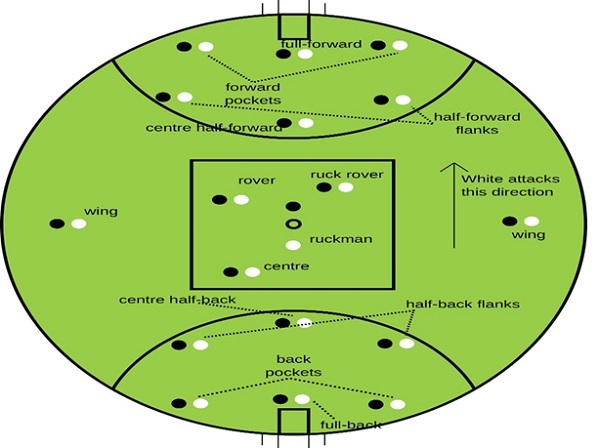A team consists of 18 players, whereas three substitute players are allowed on the bench. Free substitution is allowed at any time during a match through a designated interchange gate in front of either bench. In the arena, players are deployed in five lines, each line consisting of three players and based on their position, they are designated as left, right or center relative to the direction of attack.
The players based on their positions are as follows −
- Full Forwards − Left Forward Pocket (Left), Full Forward (Center), Right Forward Pocket (Right)
- Half Forwards − Left Half Forward (Left), Center Half Forward (Center), Right Half Forward (Right)
- Center Line − Left wing(Left), Center(Center), Right Wing (Right)
- Half Backs − Left Half Back(Left), Center Half Back(Center), Right Half Back(Right)
- Full Backs − Left Back Pocket(Left), Full Back(Center), Right Back Pocket(Right).

The players, who follow the ball, are known as followers. They are named as Ruckman, Rover, and Ruck-rover. Although players are designated based on their positions, they can move anywhere when the match is in progress. Unlike football, there is no goal keeper in Australian Football.
The Ruckman’s job is to contest for the ball with a fellow Ruckman opposing him at center- bounces at the beginning of a match. Usually players with good heights are chosen as Ruckman. The Ruck rover’s job is to handle the ball once it is tapped down by the Ruckman allowing an easy clearance. The Rover’s job is to lurk around center-bounces and receive the ball from the Ruck rover and complete a clearance.
Player Positions and their Purpose
- Full forwards are there to attack the goal and trap the ball in that area.
- Half forwards are there to set up scoring shots, attack the goal as well as trap the ball in that area.
- Center line players recover ball from back line as well as set up scoring shots.
- Half back are there to recover ball from the back line and clear ball forwards.
- Full back are there to hold the ball in that area and clear ball forwards.
Interchange Protocol
In front of the interchange gate, there is an interchange area through which all players must enter and exit the ground. A player who interchanges outside this line is not permitted to return for the rest of the match. If a player leaves on stretcher from the ground, he can return back later to the match, but he has to wait for at least 20 minutes before getting back to the match.
If a player is believed to be suffering concussion, he must come off the ground and appear or concussion test, failing which he won’t be allowed to return to the match. If a player is seen bleeding by umpire, he may be forced to leave the field immediately according to Blood Rule.
Umpires in Australian Football
There are three central or field umpires, who have full control over the match. Major roles of the umpires are to start the match, award marks and free kicks to teams and enforcing the rules of the sport. The two boundary umpires judge when the ball is out of the boundary area. They also return the ball to the center once a goal is scored. The boundary umpires are responsible for detecting players who have entered the centre square illegally.
Two goal umpires record, signal as well as judge goals that are scored in the match. Two flags are waved to indicate a goal and a single flag is waved to indicate a behind. Before goal umpire indicates the score, the field umpire signals him about no infringement on the field so that the respective score can be added.
Field umpires can’t change a decision once made except a further breach of rules by a player or team officials. Goal umpires can correct mistakes prior to the restart of a match. Goal umpires can take precedence over boundary umpires over the vicinity of a goal area. Goal umpires signals this to field umpires by tapping his hand on his chest.
